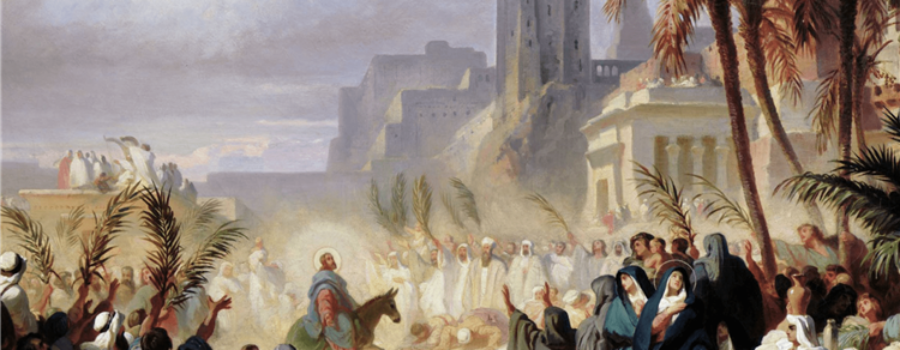Trevor Laurence
The first Palm Sunday sees Jesus’ entrance into the city of Jerusalem. Nearly every detail of the Gospels’ accounts resonates with Old Testament precursors and promises. Every step toward Zion is the unfolding of a typological drama.
Adam, the royal priest over God’s garden sanctuary, was exiled to the east after failing to guard God’s dwelling from the serpent. Jesus, a faithful Adamic priest-king, enters Jerusalem from the east and sets about expelling serpentine intruders from God’s house.
Jacob prophesied that a victorious king would arise from Judah, “binding his foal to the vine and his donkey’s colt to the choice vine” (Gen 49:11). Jesus tells two disciples that they will find “a donkey tied, and a colt with her” (Matt 21:2) for him to ride because he is the royal son of Judah who will triumph over the enemies of God’s people.
David fled Jerusalem up the Mount of Olives surrounded by weeping people (2 Sam 15:30) and was met with two donkeys (2 Sam 16:1). Jesus descends the Mount of Olives and enters Jerusalem on two donkeys, surrounded by a crowd shouting blessing upon the “Son of David” (Matt 21:9) who comes to restore the kingdom.
Solomon rode into Jerusalem atop a mule (1 Kgs 1:38–40) to take the throne and build God’s temple. Jesus rides into Jerusalem atop a donkey as the rightful Davidic heir, a king “greater than Solomon” (Matt 12:42), to judge the old temple and build a new house for the Lord.
Jehu, newly anointed as Israel’s king, traversed over laid out garments (2 Kgs 9:13) before executing judgment on Israel’s leaders and destroying the house of Baal. Jesus, Israel’s Spirit-anointed king, traverses over cloaks spread upon the road, a new Jehu who will dramatically proclaim God’s judgment on another idolatrous house and the leaders responsible for its corruption.
Zechariah anticipated a humble king mounted on a donkey, coming to Israel to defeat the enemy nations, exercise worldwide dominion, and establish peace (9:9–13). Matthew tells us that Jesus’ journey into Jerusalem on a beast of burden is in fact the arrival of this prophesied royal Savior.
Ezekiel saw God’s glory depart the temple and stand on the Mount of Olives (11:23), and Zechariah announced that one day God would stand upon the Mount of Olives (14:4) before coming with deliverance to Jerusalem to make the whole city his holy temple. Jesus travels from the Mount of Olives into Jerusalem, God’s glory-presence returning, the advent of the Holy One who will make his people his dwelling.
Amid all of these echoes of the Old Testament that proclaim profound truths about Jesus’ identity and mission, there is another biblical memory awakened by Jesus’ triumphal entry.
In Nehemiah 13, Nehemiah journeys to Jerusalem and discovers that a priest has allowed Tobiah the Ammonite—a non-Israelite enemy of God’s people—to take over a chamber in the temple. Enraged, Nehemiah throws Tobiah’s furniture out of the chamber (v. 8), orders the cleansing of God’s dwelling (v. 9), and even appoints new priestly overseers (v. 13) so that the Lord’s temple can function rightly as his holy house once again.
Jesus’ arrival in Jerusalem, overturning of tables, and cleansing of the temple recapitulates Nehemiah’s zeal for God’s dwelling place. As in Nehemiah’s day, the leaders of Israel are derelict in their duty, and the corruption they have permitted to multiply in the temple is as egregious as a Gentile adversary commandeering a room in the Lord’s house. Like Nehemiah, Jesus is an agent of deliverance who confronts the ungodly shepherds that oppress his people, drives out wickedness from God’s dwelling, commissions new priests for service, and ultimately establishes a holy temple where God’s presence may abide in blessing with humanity.
Indeed, these figural resonances alert us to an even more extended series of typological connections between Nehemiah and Jesus.
Nehemiah serves in the presence of the king (1:11). Upon hearing of his people’s “great trouble and shame” (1:3), he descends from his exalted position, sent by the king to rebuild the city of God (2:5). He dwells among—joins himself to—his people, who, though they have been restored to the land, still experience the slavery of lingering exile (9:36). Though the hand of God is upon him (2:18), Nehemiah is opposed from the beginning (2:19), and the opposition grows over time into conspiracy, lies, and false accusations that Nehemiah is setting himself up as a rival king (6:7). Neverthless, Nehemiah accomplishes the purpose for which he was sent, and even his enemies are made to see that his work was the work of God (6:16).
When Jesus enters Jerusalem on the first Palm Sunday, he enacts a script that signals his multi-faceted identity as the fulfiller of God’s promises and Israel’s hopes. He is David and Solomon and Jehu and Yahweh, and he is Nehemiah, too—the descending deliverer who rebuilds the glory of Zion and ensures that God and his people may dwell in holiness together.
This article originally appeared in the Cateclesia Newsletter. Subscribe to stay informed with updates, resources, and reflections from the Cateclesia Institute.
Trevor Laurence is the Executive Director of the Cateclesia Institute and the author of Cursing with God: The Imprecatory Psalms and the Ethics of Christian Prayer (Baylor University Press, 2022).
Image: Félix Louis Leullier, Christ’s Triumphal Entry into Jerusalem

